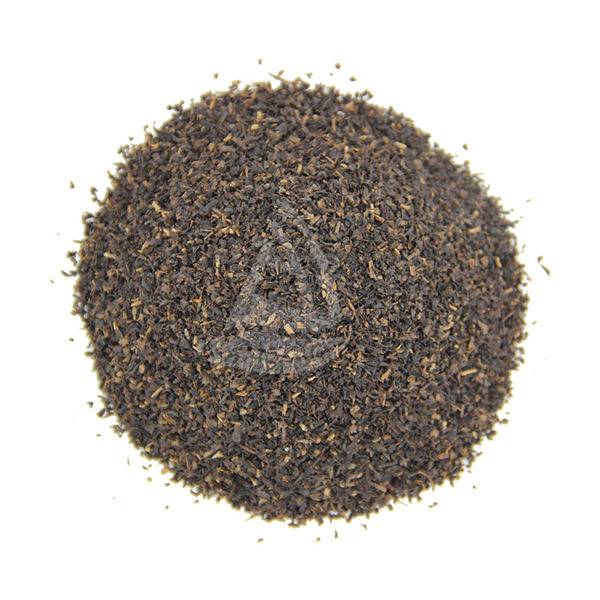Broken Black tea
|
Product name |
Broken Black tea |
|
Tea series |
Broken Black tea |
|
Origin |
Sichuan Province, China |
|
Appearance |
Broken |
|
AROMA |
Fresh and strong aroma |
|
Taste |
mellow taste, |
|
Packing |
4g/bag,4g*30bgs/box for gift packing |
|
25g, 100g, 125g, 200g, 250g, 500g, 1000g, 5000g for paper box or tin |
|
|
1KG,5KG,20KG,40KG for wooden case |
|
|
30KG,40KG,50KG for plastic bag or gunny bag |
|
|
Any other packaging as customer's requirements are OK |
|
| MOQ |
8 TONS |
| Manufactures |
YIBIN SHUANGXING TEA INDUSTRY CO.,LTD |
| Storage |
Keep in dry and cool place for long-term storage |
|
Market |
Africa, Europe, Middle East, Middle Asia |
|
Certificate |
Quality certificate, Phytosanitary certificate, ISO,QS,CIQ,HALAL and others as requirements |
|
Sample |
Free sample |
|
Delivery time |
20-35 days after order details confirmed |
|
Fob port |
YIBIN/CHONGQING |
|
Payment terms |
T/T |
Sample
Free sample
Broken black tea is a kind of broken or granular tea. It is a bulk product in the international tea market. It accounts for about 80% of the total global tea exports. It has a history of more than 100 years of production.
The finished black tea is broken or granular in appearance, the soup is bright red, the aroma is fresh, the taste is mellow.
Production process:
Withering, twisting or kneading, fermenting, drying
Broken black tea is divided into traditional and non-traditional process according to the production process. Non-traditional process are divided into Rotorvane process, C. T.C process, Legger process and L.T.P process. The product quality and style of various preparation process are different, but the color classification of broken black tea and the appearance specifications of each type are basically the same. Broken black tea is divided into four color specifications: leaf tea, broken tea, sliced tea, and powdered tea. The leaf teas form strips outside, requiring tight knots, long glumes, uniform, pure color, and gold (or little or no gold). The endoplasmic soup is bright red (or bright red), with a strong fragrance and irritating. According to its quality, it is divided into "Flowery Orange Pekoe" (F. O.P) and "Orange Yellow Pekoe" (O.P). The shape of the broken tea is granular, and the granules are required to be uniform in weight, containing a few cents (or no cents), and a smooth color. The inner soup has a strong red color and a fresh and strong fragrance. According to the quality, it is divided into "flowery orange and yellow pekoe" (Flowery). Broken Orange Pokoe (FB.OP), "Broken Orange Pokoe" (BOP), Broken Pekoe (BP) and other colors. The shape of the sliced tea is fungus-shaped flakes, it is required to be heavy and even, the soup is red and bright and the fragrance is strong. According to the quality, it is divided into "Flowery Broken Orange Pekoe Fanning" (FBOPF) and "FBOPF" (referred to as FBOPF). BOPF), "Pekko Chips" (PF), "Orange Chips" (OF) and "Chips" (F) and other designs. The powdered tea (Dust, D for short) is in the shape of sand grains, and requires uniform weight and smooth color. The inner soup is reddish and slightly darker, and the aroma is strong and slightly astringent. For the above four types, leaf tea cannot contain fragments of tea, broken tea does not contain flakes of tea, and powdered tea does not contain tea ash. The specifications are clear and the requirements are strict.
Precautions:
1. Temperature: The higher the temperature, the faster the quality of the tea will change. The browning speed of the tea will increase 3-5 times for every ten degrees Celsius increase. If the tea is stored in a place below zero degrees Celsius, the aging and quality loss of the tea can be suppressed.
2. Moisture: When the moisture content of tea is about 3%, the composition of tea and water molecules are in a single-layer molecular relationship. Therefore, the lipids can be effectively separated from the oxygen molecules in the air to prevent the oxidative deterioration of the lipids. When the moisture content of tea leaves exceeds 5%, the moisture will be transformed into solvents, causing intense chemical changes and accelerating the deterioration of tea leaves.

3. Oxygen: The oxidation of polyphenols in tea, the oxidation of vitamin C, and the oxidative polymerization of theaflavins and thearubigins, are all related to oxygen. These oxidations can produce stale substances and severely damage the quality of tea.
4. Light: The irradiation of light accelerates the progress of various chemical reactions and has an extremely adverse effect on the storage of tea. Light can promote the oxidation of plant pigments or lipids, especially chlorophyll is susceptible to fading by light, and ultraviolet rays are the most significant .

Storage method:
Quicklime storage method: Pack the tea, arrange the layered ring around the ceramic altar, then pack the quicklime in a cloth bag and place it in the middle of the tea bag, seal the mouth of the altar, and place it in a dry, cool place. It is best to change the quicklime bag every 1 to 2 months.
Charcoal storage method: Take 1000 grams of charcoal into a small cloth bag, put it into the bottom of a tile altar or a small iron box, and then arrange the packed tea leaves on top of it in layers and fill the mouth of the sealed altar. The charcoal should be replaced once a month.
Refrigerated storage method: Put new tea with a moisture content of less than 6% into iron or wooden tea cans, seal the can with tape, and put it in the refrigerator at 5°C.













